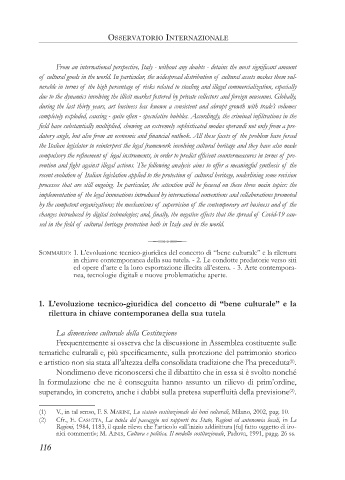Page 118 - Rassegna 2021-2
P. 118
OSSERVATORIO INTERNAZIONALE
From an international perspective, Italy - without any doubts - detains the most significant amount
of cultural goods in the world. In particular, the widespread distribution of cultural assets makes them vul-
nerable in terms of the high percentage of risks related to stealing and illegal commercialization, especially
due to the dynamics involving the illicit market fostered by private collectors and foreign museums. Globally,
during the last thirty years, art business has known a consistent and abrupt growth with trade’s volumes
completely exploded, causing - quite often - speculative bubbles. Accordingly, the criminal infiltrations in the
field have substantially multiplied, showing an extremely sophisticated modus operandi not only from a pre-
datory angle, but also from an economic and financial outlook. All these facets of the problem have forced
the Italian legislator to reinterpret the legal framework involving cultural heritage and they have also made
compulsory the refinement of legal instruments, in order to predict efficient countermeasures in terms of pre-
vention and fight against illegal actions. The following analysis aims to offer a meaningful synthesis of the
recent evolution of Italian legislation applied to the protection of cultural heritage, underlining some revision
processes that are still ongoing. In particular, the attention will be focused on these three main topics: the
implementation of the legal innovations introduced by international conventions and collaborations promoted
by the competent organizations; the mechanisms of supervision of the contemporary art business and of the
changes introduced by digital technologies; and, finally, the negative effects that the spread of Covid-19 cau-
sed in the field of cultural heritage protection both in Italy and in the world.
!
SOMMARIO: 1. L’evoluzione tecnico-giuridica del concetto di “bene culturale” e la rilettura
in chiave contemporanea della sua tutela. - 2. Le condotte predatorie verso siti
ed opere d’arte e la loro esportazione illecita all’estero. - 3. Arte contempora-
nea, tecnologie digitali e nuove problematiche aperte.
1. L’evoluzione tecnico-giuridica del concetto di “bene culturale” e la
rilettura in chiave contemporanea della sua tutela
La dimensione culturale della Costituzione
Frequentemente si osserva che la discussione in Assemblea costituente sulle
tematiche culturali e, più specificamente, sulla protezione del patrimonio storico
e artistico non sia stata all’altezza della consolidata tradizione che l’ha preceduta .
(1)
Nondimeno deve riconoscersi che il dibattito che in essa si è svolto nonché
la formulazione che ne è conseguita hanno assunto un rilievo di prim’ordine,
superando, in concreto, anche i dubbi sulla pretesa superfluità della previsione .
(2)
(1) V., in tal senso, F. S. MARINI, Lo statuto costituzionale dei beni culturali, Milano, 2002, pag. 10.
(2) Cfr., E. CASETTA, La tutela del paesaggio nei rapporti tra Stato, Regioni ed autonomia locali, in Le
Regioni, 1984, 1183, il quale rileva che l’articolo «all’inizio addirittura [fu] fatto oggetto di iro-
nici commenti»; M. AINIS, Cultura e politica. Il modello costituzionale, Padova, 1991, pagg. 26 ss.
116

